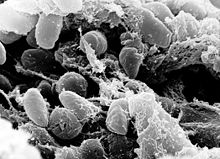Our website is made possible by displaying online advertisements to our visitors.
Please consider supporting us by disabling your ad blocker.
Pneumonic plague
| Pneumonic plague | |
|---|---|
 | |
| A scanning electron micrograph depicting a mass of Yersinia pestis bacteria | |
| Specialty | Infectious disease |
| Symptoms | Fever, headache, shortness of breath, cough, hemoptysis[1] |
| Usual onset | 3 to 7 days[2] |
| Causes | Yersinia pestis[3] |
| Risk factors | Rodents[3] |
| Diagnostic method | Sputum testing[1] |
| Treatment | Antibiotics[1] |
| Prognosis | Invariably fatal when left untreated[4] |
| Frequency | Rare[2] |
Pneumonic plague is a severe lung infection caused by the bacterium Yersinia pestis.[3] Symptoms include fever, headache, shortness of breath, chest pain, and coughing.[1] They typically start about three to seven days after exposure.[2] It is one of three forms of plague, the other two being septicemic plague and bubonic plague.[3]
The pneumonic form may occur following an initial bubonic or septicemic plague infection.[3] It may also result from breathing in airborne droplets from another person or animal infected with pneumonic plague.[1] The difference between the forms of plague is the location of infection; in pneumonic plague the infection is in the lungs, in bubonic plague the lymph nodes, and in septicemic plague within the blood.[3] Diagnosis is by testing the blood, sputum, or fluid from a lymph node.[1]
While vaccines are being developed, in most countries they are not yet commercially available.[1][3] Prevention is by avoiding contact with infected rodents, people, or cats.[1][3] It is recommended that those infected be isolated from others.[2] Treatment of pneumonic plague consists of antibiotics.[1]
Plague is present among rodents in Africa, the Americas, and Asia.[3] Pneumonic plague is more serious and less common than bubonic plague.[1] The total reported number of cases of all types of plague in 2013 was 783.[2] Left untreated, pneumonic plague is almost always fatal.[5] Some hypothesize that the pneumonic version of the plague was mainly responsible for the Black Death that resulted in approximately 75 - 200 million deaths in the 1300s.[2][6]
- ^ a b c d e f g h i j "FAQ Plague". www.cdc.gov. Archived from the original on 14 March 2017. Retrieved 13 March 2017.
- ^ a b c d e f "Plague". World Health Organization. September 2016. Archived from the original on 24 April 2015. Retrieved 14 March 2017.
- ^ a b c d e f g h i "Plague". www.who.int. Archived from the original on 19 March 2017. Retrieved 14 March 2017.
- ^ who, who. "plague". who.int. WHO. Retrieved 23 June 2022.
- ^ http://www.cfsph.iastate.edu/Factsheets/pdfs/plague.pdf
- ^ McCoy, Terrence (31 March 2014). "Everything you know about the Black Death is wrong". Washington Post. The Washington Post. Archived from the original on 27 August 2016. Retrieved 14 March 2017.
Previous Page Next Page


